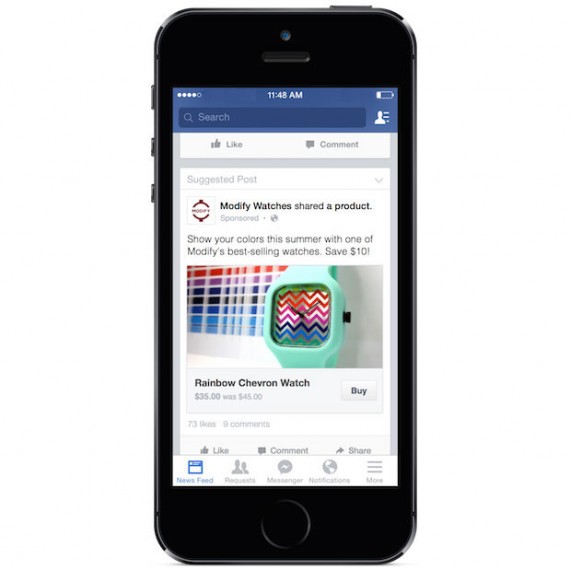Facebook announced last week that it is testing a new feature with select smaller businesses that would allow users to purchase products directly from those businesses without leaving Facebook.
Companies included in the test can insert a “Buy” button into sponsored posts that appear in News Feed so that people can purchase whatever is offered, instead of simply “liking” the post.

Facebook tests “Buy” button (beneath the photo, above, on the right) with select smaller businesses.
Facebook derives most of its income from advertising. Even though ad revenues have risen substantially, Facebook needs to find ways to diversify. The ability to obtain revenue from on-site sales transactions or raise advertising rates as a result may be too much of a draw for Facebook to pass up.
Further, Facebook is in a race against Twitter, which, on the same day Facebook announced the “Buy” button, made its own announcement: the purchase of CardSpring, a payment processing app-development company that will presumably make it easy to pay for products directly within Twitter.
Emphasis on Privacy
Facebook said it built the feature with privacy in mind and has taken steps to make the payment experience secure. “None of the credit or debit card information people share with Facebook when completing a transaction will be shared with other advertisers, and people can select whether or not they’d like to save payment information for future purchases,” said the announcement.
Based on Facebook’s reported manipulation of users’ feeds without their knowledge in order to conduct a psychological experiment, it remains to be seen whether people will hand over their credit card information that willingly.
Other F-commerce Attempts
This is not the first time Facebook has attempted to sell products directly on its site.
You may recall Facebook Marketplace in 2007, where people could list items for sale in a manner similar to a newspaper or Craigslist classified ad. In 2009, Facebook turned Marketplace over to online classifieds company Oodle, which built a new version of the service that exists today.
In 2009, the company introduced Facebook Credits, a virtual currency that enabled users to make purchases for games and virtual goods. It was shut down in 2012. Also in 2012, Facebook Gifts, which allowed the purchase of physical gifts to be sent to friends, was tried and failed. (Facebook currently offers a variation of Gifts where users can send gift cards to friends on their birthday, or to celebrate other meaningful moments in their life.)
At the most recent f8 conference, Facebook announced a deal with social commerce platform provider Ecwid to use Ecwid’s mobile payment feature, Autofill, which gives customers the ability to use payment information stored on their Facebook account to complete the purchase.
New Feature a Double-edged Sword for Merchants
The “Buy” button is a convenience to Facebook users who, once they get to the site, don’t want to leave. However, for the more than 30 million businesses that use Facebook — many are smaller ecommerce merchants — the feature is a double-edged sword.
It would enable businesses to generate revenue directly from the sponsored post ad, which could help those businesses. But by keeping buyers on its site, Facebook retains control over the process, which means the buyer never gets to the retailer’s website where the possibility of seeing other products or making additional purchases exists. Neither does the retailer benefit from gathering customer data. That, too, remains under Facebook’s purview.
Conclusion
In 2010, Facebook founder Mark Zuckerberg famously said, “If I had to guess, social commerce is the next thing to blow up.”
Even if the “Buy” button follows the same trajectory as previous ecommerce attempts, I would not be surprised to see Facebook continue integrating ecommerce into its platform. That could be the next step to help Facebook make even more money.




